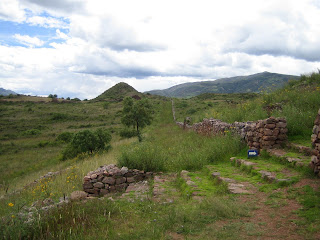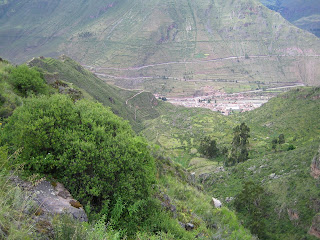Board an airplane in Arequipa and fly to Cusco. Admire the beauty of sunrise on the mountains.
06:35, Day One:
Land in Cusco, which in February is green and lush, ringed by snow-capped mountains.
07:00, Day One:
Check into the opulent Hotel El Libertador, and enjoy a cup of coca leaf tea. Settle into hotel room and have a leisurely breakfast in the hotel dining room.
09:30, Day One:
Take a taxi to Tipon, an Inca complex southeast of Cusco. Tipon is known for its beautiful waterworks and geometrically complex terraces. The name Tipon comes from a Quechua word, "timpuj," meaning "boiling," and it is thought to refer to the way the water bubbles up out of the underground spring which feeds the irrigation system. After touring the lower, main section on our own, we climbed up to a temple area on a hill overlooking the valley. There we met a caretaker who offered to take us further up one of the channels that was partially destroyed (and thus dried up) in a 1950 earthquake. Our new guide told us that the crops grown at Cusco had been sacred crops of quinoa, kiwicha, corn, potatoes, and medicinal herbs. The ruins sit at 3,560 metres above sea level, and there are fields above the ruins, still being farmed.
12:30, Day One
Sunburned and winded, but having greatly enjoyed ourselves, we carried on in the taxi a little further down the valley to the pr-Incan Wari ruins at Pikillacta. Apparently "piki" means "flea" in Quechua, and our driver told us this name came from the construction techniques used at the site, with many small rocks of varying sizes. Another gentleman at the site, however, told us that the flea reference was made with regard to the densely packed 10,000 inhabitants of the city.
The city walls stretch out for kilometres:

Clover-blanketed fields above the chaos of the ruined city:
14:00, Day One
We grabbed a bottle of coke on the way back to Cusco, driving through intermittent rain the whole way. When we arrived back at the hotel, we noticed that the Koricancha and Dominican church was open. We inquired as to its closing time, and headed out through the colorful Cusco streets in search of lunch.
14:30, Day One:
Los Perros Couch Bar is a hip, laid-back option for a drink and a meal at the corner of Tigre and Tecsecocha streets, just a block off the Plaza de Armas. We shared a plate of fried cassava with blue cheese dressing, a bowl of curried pumpkin soup with fresh bread, and a lovely dish of stirfried chicken in an Asian-inspired dressing over sweet potato chips. After all this delicious food, and a couple of icy cold Cusquena beers, we were ready to hit the streets again.
The dome of the Koricancha, as seen from our hotel room window:
16:00, Day One:
We walked back toward our hotel, stopping in at the incomprable Moni vegetarian restaurant and cafe, for a take away latte to counteract the beers. Sufficiently revived, we carried on to the Koricancha. This amazing complex is a Dominican church built over the main temple of the Inti, or Sun God, in Cusco. Also called the Temple of the Sun, the Koricancha's breathtakingly perfect stonework was lavishly accented with gold inlay and leaf when the Spanish arrived, and was said to house a fortune in gold idols and decorations. Of course, this wealth was taken by the Spanish and none remains in the site today, but the Koricancha remains a truly lovely meeting of Inca and Spanish architecture, and is certainly deserving of its World Heritage Site status. Photography was not permitted, but please do click here to see a few shots of this beautiful building.
17:00, Day One:
After a long day, we settled back in our room at the Libertador for baths, naps, and some quiet reading. Rather unwisely, we turned on the television and got sucked into a movie.
19:30, Day One:
We got dressed up and went down to the bar in the Libertador for a pisco sour. The bartender wrote fancy "L"s in bitters on top of each drink. This resulted in quite a lot more bitters taste than comes with the usual drop or two on the drink, but it was lovely. We got chatting with the bartender, who has a brother in Mississauga, and eventually we headed out towards the fabulous Monasterio hotel. In the lobby bar of this historic monastery, built in 1592, we enjoyed a couple more pisco sours. These ones were outrageously priced at 26 soles, or nearly ten Canadian dollars a piece. But they were truly delicious, and came with complementary canapes and impeccable service.
After our second round of pisco sours, we wandered rather tipsily into the square to the MAP (Museo de Arte Precolombiano) restaurant across the street, only to discover that it had already closed for the night, as it was now 9:30 pm. We headed over to the Plaza de Armas and had a perfectly acceptable dinner at Bohemie restaurant instead.
23:00, Day One:
After a quick stop to pick up bottled water and bandaids for my blistered toes, we retired to the hotel for a good night's sleep.
06:30, Day Two:
We got up, packed out the room, and enjoyed the breakfast buffet. I've had better hotel breakfasts, but it was perfectly acceptable. We checked out of the hotel after breakfast.
07:00, Day Two:
Our trusty driver was waiting bright and early to take us to Pisac, first stop in the Sacred Valley. Most visitors to Pisac only see the market, and that had been our fate the first time around in Cusco. This time, however, we were bound and determined to see the ruins that perch on a clifftop over the town in the valley.
From below, the terracing at the ruins is quite impressive.
08:00, Day Two:
We arrived at the top of the ruins, and our driver gave us a brief explanation of the four main complexes of the site. He told us he would meet us much further down the hill, at the parking lot.
The first stop was a series of warehouses that had been used for storing crops:
The second complex was the residential area for the farmers, who lived here for a year at a time paying their debt in work to the Inca and the sun god:
We climbed to the top of the mountainous ruin, from which we had an excellent view of the valley and the town of Pisac below:
Here we see, from above, the complex within which the nobles would have lived:
This is the temple complex, and it showcases the truly stunning stonework that can be seen exclusively in sacred or religious Inca constructions. The complex also houses one of the very few remaining Intihuatanas - a carved stone which reveals the seasonal changes of the sun's position, and acted as a guide for timing holy days and important agricultural dates:
The Intihuatana:
Lonely watchtowers and guard posts perch dizzily on the cliff that hangs over the modern town of Pisac:
11:30, Day Two:
After almost three hours touring the gorgeous Pisac ruins, we returned in the rain to Cusco. We toured the MAP museum, and then ate a lovely lunch in its airy, modern restaurant (below) before heading to the airport. We flew back to Arequipa via Juliaca, from which we caught a glimpse of Lake Titicaca, and arrived home exhausted and happy at 5:00 pm.















2 comments:
I just love this entry. Feel like I was there. Is there some way that you can archive your entire blog from the begining and store it somewhere for the long-term? How does that work anyway? Is it just out there in the ether somewhere? Can it be tranferred to DVDs or something? Just curious. It would be great if you could have it still available in 30 years time.
Thanks - I was inspired by the NYT "36 Hours In . . . " travel writing.
Right now it's all out in the ether. I should really back it up on my hard drive, or print it all out, or something.
Post a Comment